This Saturday, the Indianapolis Cultural Trail is throwing a Grand Opening party like none other. Â Titled Get Down On It, the party features events for all ages to celebrate the completion of the trail. Â There have been many delays, frustrations, and even a time where people were wondering if there was enough funding for the trail to be completed. Â It took years of dedication, but it is finally complete*.
Here at Urban Indy, we thought it would be a good idea to offer some of our thoughts about the trail and place them in this post.
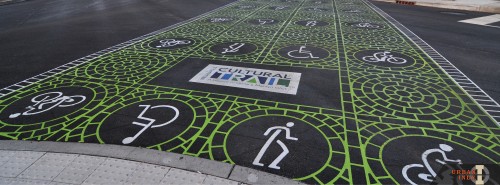
Curtis Ailes:
The Cultural Trail is a piece of infrastructure unparalleled in any major city anywhere. Indianapolis continues to show it can compete with big city projects elsewhere with this new world class bicycle and pedestrian trail. As a supporter of bicycle and pedestrian rights, it pains me when I see some of our biggest downtown names such as the Conrad turning their back on this project instead of embracing it for what it is and hopefully, as the community continues to grow support for the trail, popular sentiment will overturn what is a bad decision to allow cars to be valet parked along the hotel’s frontage. That said, the sum of the trail is a magnificent and unique achievement that everyone in Indianapolis should be proud of! I will continue to take advantage of this amenity and encourage others to as well.
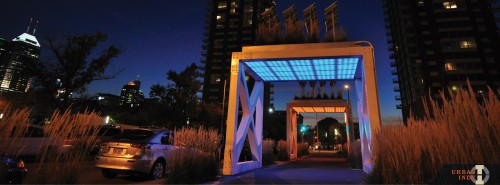
Kevin Kastner:
At first, it was very possible that the Cultural Trail would be another pie-in-the sky idea, destined to be relegated to the dustbin of history like so many other plans. Â But the team behind the idea was committed to the mission of building a world class piece of pedestrian and bicycling infrastructure in downtown Indianapolis. Â The city now has its urban showpiece, which shows up as a template for other cities that want to see their own version of the trail. This weekend’s event, just like the trail itself, is about celebrating Indy’s citizens and its visitors. Â It’s a moment to be proud in all that has been accomplished, as well as looking forward to what is yet to come.
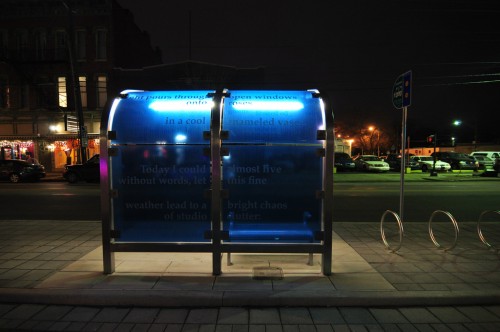
 Graeme Sharpe
This trail is a big deal for us at Urban Indy. We have been ecstatic to see the city embrace this. It is hard to understate how rapidly and deeply this is changing the city.
But the Cultural Trail is more than a piece of infrastructure. It is also an invitation for people to participate in this experiment of participatory urban design. It is a common anthem we hear in Indianapolis that common people can do amazing things by getting involved, and nothing proves it better than the Cultural Trail (also see here and here).  When we have a coffeeshop meeting with urbanists these days the discussion is no longer about what we’ve lost, but what is coming next. Eugene and Marilyn Glick are now just as famous as their sponsored piece of world-class infrastructure, and we are all excited to see how will others make their own mark on the city.
The celebration weekend will feature many great photos showing how awesome these new spaces are. And the Cultural Trail is truly awesome. But a quick look at what used to be here shows how much courage and vision it took to visualize the change that needed to happen. How many people really saw the potential to turn this ugly, unloved, and forgotten streetscape into a world-famous concept? Every city has these spaces, every city has potential. Many, many opportunities remain.
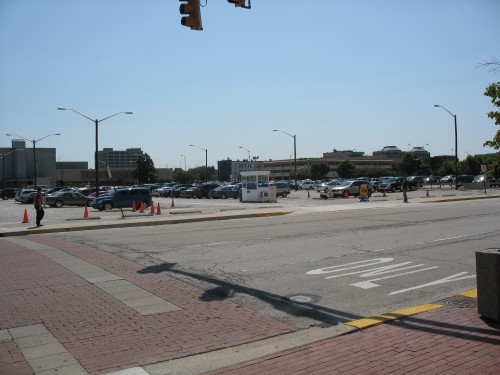
Joe Smoker
When we break it down, the Cultural Trail is essentially a sidewalk. It runs adjacent to local streets and is separated from our streets by curbs and gutters and occasionally trees, plants and lighting. It has signalized, at-grade crossings at intersections and connects people with places. So why do we care? We care because it was done right. We care because sidewalks aren’t national headlines (at least positively) and are certainly not substantial pieces of mainstream media coverage. No my friends, I am wrong. This is not essentially a sidewalk. The Cultural Trail is much more. What we have been gifted, is the Robert Moses parkway of our day, negating the completely opposite impacts on our built environment. Just as the parkways of New York spurred the imaginations of millions of residents about what was achievable, the Cultural Trail has provided Indy with a common thread weaving together the fabric of a city long thought to be disconnected and out of touch.
When asked to describe our investment, we hear about linear parks and greenways, art installations and connectors, dedicated infrastructure for pedestrians and a chance for recreation. So what do we have? The answer…..Yes. The Cultural Trail is yours to mold. Personally, I believe what we have before us, is a piece of infrastructure, so well thought out, that I can tell visitors and friends alike that their is a self-guided tour of the heart of the city, drawing together substantial aspects of culture and creating a community not seen for decades.
I can’t quote fact as I sit here and type, that the Cultural Trail has drawn an increase in population to the core of the city. What I can tell you, is that the CT has organized and improved the way people get around. We speak in great detail about the benefits of fixed guideway transit and its relation to development, business and density. Consider this a fair description of the impacts of the Trail. It is rare that we see substantial changes to a neighborhood in a lifetime, and certainly unheard of to see such drastic change within a decade, yet places like Fountain Square show the true power of the Trail. I recall not even five years ago spending time within Fountain Square, thinking about how great the area must have been. If only the streetcars hadn’t been removed and if only the interstate hadn’t effectively removed Fountain Square’s connection to the revitalized core. Now, the investment, spurred in strong part because of the Trail, has not only injected a vitality into Fountain Square similar to Mass Ave, but the Trail has established a connection to Downtown long thought lost. Development that, as a rule, arranged their buildings to front parking lots, now actively engages the street and the trail.
People often say Indy has no major natural features. We have little river access or availability, we have no mountains and we certainly lack beach front property. To those, I say we have innovators, collaborators and community-driven minds that work to make change happen. You can keep your big rocks and water filled holes, I’ve got something much more substantial. Go enjoy your Trail and ‘Get Down On It’.
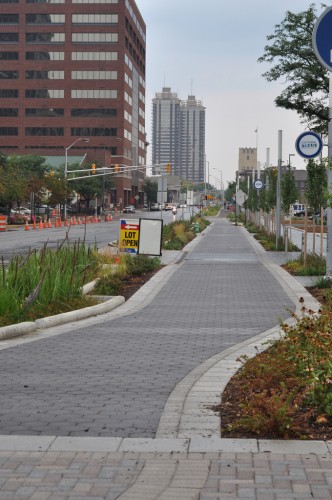
I take the trail a minimum of 4 times a week and this week I’m already up to 7 and it’s only Wednesday. I know others are loving it too because on my trip from Fletcher Place to Ransom Place, I saw over 100 bikes and at least 20 joggers. That doesn’t count all the people just leisurely walking to get lunch or walking to work.
I hope the grand opening helps to introduce even more people to the trail.
I really hope that the folks behind the trail are already working on a sequel/extension for the trail. There are so many other nearby neighborhoods that could use some connecting (Bates-Hendricks, Cottage Home, Arsenal Heights, Woodruff Place, Holy Cross, and Old Northside).
What do you use it for? Do you spend money near it?
My main use is commuting my daughters to school (which we pay tuition for). Other uses are food and entertainment in Fountain Square (and Mass Ave some), trips to the library, groceries at Marsh, Pacers games, dinner/drinks downtown. Our trips to other neighborhoods have probably at least doubled since it was finished on Virginia Ave.
After a little more thinking another big thing about the trail is the massive modal shift it has created for me. Before I would say that about 10% of our trips to downtownish destinations were by bike or walk. Now we are closer to 80%. All of that gas money is non-local dollars. A good portion of the maintenance cost is not very local (parts non-local, labor is in Greenwood). All the externalities are local – wear and tear on the road, pollution, and increased stress for me and others. So I would say that economically, even if it isn’t pure dollars, the Cultural Trail is providing some pretty major benefits.
I love the Cultural Trail and it is reason alone for anyone to go downtown for a walk or bike, but I just have an odd feeling about how much impact it will have on neighborhood commercial areas. I think the success is how well it connects the surrounding downtown area, maybe not as much of how it will impact a specific neighborhood. It’s not going to bring through the amount of people transit would have (Monon) and it’s yet to be determined how much economic impact the trail has had on abutting properties, especially businesses.
Joe, I disagree with the Fountain Sq. cite. That neighborhood was well on it’s way back before the Cultural Trail as a result of the “Creative Class”, and it is still a great distance and fractured from downtown and other neighborhoods. Side note- crime is still quite high in the area.
A few pics from northern Mass Ave, probably would’ve never ventured to this area if it weren’t for the trail- http://groundlevelmw.blogspot.com/2013/01/the-beauty-of-indianapolis-cultural.html
Eric, it was nice meeting you. Your photos are amazing. I love this site too. Thanks for telling me about it. Come back in Cultural Swirl soon and say Hello 🙂
Love this trail! I use is every time I bike downtown from Broadripple, whereas before the trail I would ride to the southern Monon terminus and then…what? Strap up and brave the streets I guess, which is something that most folks will not do. The trail will do for Indy what Copenhagen’s separated bike infrastructure did for them…get people riding who are afraid to ride painted bike lanes.
I also use it every time I bike between Methodist and University hospitals for work. Faster than the People Mover, and a lot more fun!
If the Mayor would replace the leadership in DPW with those of the CT team, then I’d really be excited about the future of Indianapolis.
Then don’t say a word about the salary expenses as most of the team was consultants.
Aidan,
It’s not about the cost, it’s about the mindset of how streets should be designed. The Mayor could replace the DPW leadership team with plenty of people in this community who would do the job correctly and for the same or lesser salaries.
Agree. I would be willing to work on something like this for not a whole lot. I feel like it would be something that I could really enjoy.
Unfortunately, there would probably be a lot of politics that would make it not nearly as fun as I imagine.
It should be noted that the DPW leadership has been involved in the Cultural Trail every step of the way. The CT team did a wonderful job of raising private dollars, garnering community support and overseeing design and construction for the trail, but the fact of the is that an infrastructure project this large never would have happened without a lot of support from DPW.
DPW’s leaders have helped with everything from coordinating with utilities, support on grant applications and assistance with economic impact studies and more.
Do you really want to replace the leaders at DPW, the same leaders who have built a model for how government and non-profit partners should work together to build world class infrastructure projects in this city? I don’t.
I was going to point out this very thing. The current director and her key engineering people were the folks who helped make this happen.
Yes, I’d really replace them, immediately. They can’t or won’t design streets properly, unless it’s some special project like the CT where someone else is taking the lead. As others have pointed out, they all serve at the pleasure of the mayor (and of course the DPW aren’t elected), so I’ll vote for a different mayor, hopefully one who understands and places an emphasis on appropriate urban design.
In the meantime, I’ll continue to attempt to give my opinion, and cross my fingers in the hope that they do a better job on routine projects.
Scott, I wouldn’t brag about coordination with utilities, nor would I talk about DPW’s support on the grant applications.
I won’t get into the messy details on here that could taint an otherwise great project.